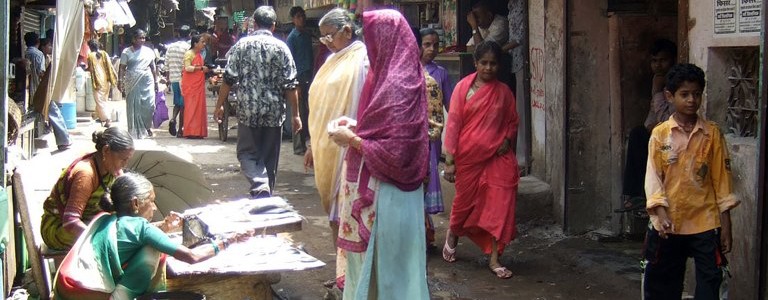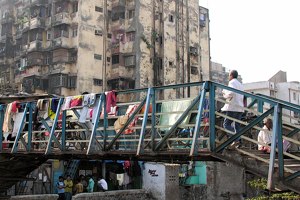
Any Slumdog Millionaire fan will probably be familiar with the Dharavi slum. Spreading 535 acres across Mumbai, it is one of the largest slums in the world. The exact population is unknown, but estimates range from 300,000 up to one million.
I become a slum tourist

One of the Entrances to the Dharavi Slum, Mumba
Yesterday, I went on a guided tour of Dharavi, spending two and a half hours walking the streets and alleys of the slum, learning about how the residents live and work day to day. Many people assert that slum tourism is the commercialisation of poverty, and that the tour companies profit from the poor. The company that runs the Dharavi tours maintains that 80% of their profits are used to fund health, education and other projects which benefit the residents of the slum. Just before the tour begins, our tour guide explains that the purpose of the tour is to dispel the image of slums as just places of poverty and negative stereotypes of those who live in slums. He also explains that the slum community understands the tour companies goals and agree to the tours taking place. Photography is not allowed whilst inside the slum.
The tour began in the industrial part of Dharavi where plastic is collected and processed into pellets to be sold to make new plastic products. Aluminium recycling is also done here. The men work in factories without safety gear and almost no ventilation. The workers here are not from Mumbai, but have travelled to the capital to find work. They work, sleep and live inside the factories.
We then moved into the residential area of the slum which is a maze of streets and narrow alleys with many houses less than 10 square meters. The ground is often wet and slippery with mud. Here, we also saw a lot of production being undertaken by residents. There were many making pottery, and women sat on the street rolling out papadams that would later be sold.
In retrospect …………….
The slum tour was definitely eye-opening and I learnt a lot about the lives of the so many people who live in Dharavi. Our tour guide was keen to highlight the community spirit within the slum, and the pride people have in the different types of work they undertake. But there is no denying the substandard conditions in which they live. Hundreds of thousands of people share just 700 public toilets, and children play cricket on top of piles of rubbish, dirt and sewage.
The Dharavi slum tour is definitely an experience that will make you think about your own life and the lives of the many that are less fortunate. I am still not sure where I stand on the “commercialisation of poverty” issue, but it is certainly one that deserves attention and consideration.






